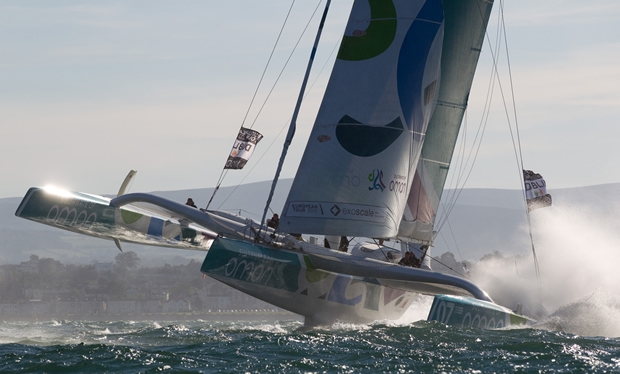
Sidney Gavignet on the MOD70s
French Volvo Ocean Race veteran turned multihull sailor Sidney Gavignet still had something of the ‘cat that had got the cream’ about him when we spoke to him last week. Musandam-Oman Sail, the MOD70 he skippers, had demolished the opposition on leg four of the one design trimaran circuit’s European Tour into Marseille, a special place for him as it was where he trained during his formative years as a sailor. This was also the first significant victory for the new Omani trimaran since she was launched this spring.
Gavignet, who’s lengthy Volvo Ocean Race career started on the maxi ketch La Poste and continued on to Assa Abloy, then winning with Mike Sanderson’s team in 2005-6 on ABN AMRO One and then coming second with Ken Read’s team on Puma in 2008-9, joined Oman Sail in 2010 when he skippered their 105ft trimaran Oman Air Majan singlehanded in the Route du Rhum. Sadly this came to a sorry end when the boat broke to the north of the Azores and had to be abandoned.
Committed to having a large trimaran as the flagship project within their expanding portfolio of sailing classes, Oman Sail then opted for the fledgling MOD70 class, continuing with Gavignet as their skipper.
“I enjoy it a lot,” says Gavignet of the MOD70 class. “It is ideal I think. The concept is perfect for the period, the budgets are quite a bit cheaper than other things like the Volvo. And it is spectacular. It goes fast from one place to another, which is important to reach markets. They are reliable – I think we have proved it now as we have been sailing them a lot.”
The MOD70 was born following some 20 years worth of engineering data from the ORMA 60 trimarans, plus a safety margin has been added to them improving reliability still further. “People who sailed on the ORMA 60s say that these boats are stiffer. And I think we are faster than the ORMAs were,” says Gavignet.
However one problem with the boats has materialised in the retractable curved lifting foils in the floats. They broke one on Musandam-Oman Sail while transatlantic in the Krys Ocean Race and another on Groupe Edmond de Rothschild almost went the same way. As a result the boards on all five MOD70s now have a special little chokes bonded onto the side of them so that they can no longer be dropped to the full extent. This is supposed to reduce flex/twist on the foil by around 30%. To get the boards to work harder, teams in the stopovers of the European Tour were adjusting the board’s pitch, but they still haven’t managed to develop as much lift off them as there was before.
Back to the attributes of the MOD 70 and Gavignet continues: “The level is tight too and it is nice to sail, it is a really nice boat. You change something and you feel it on the helm. And it is ideal for Oman Sail because there is no development, it is enough to develop ourselves. You don’t need a big background [in offshore multihulls] - it is open to anyone.”
When Gavignet says ‘develop ourselves’, among the six crew of Musandam-Oman Sail competing in the MOD70 European Tour alongside Brian Thompson, Jef Cuzon and Thomas le Breton are two Omanis – Fahad Al Hasni, who competed on the Omani boat in the Tour Voile last year; Mohsin Al Busaidi, the first Arab to sail non-stop around the world and with The Wave, Muscat Extreme 40 crewman Khamis Al Anbouri, filling in occasionally.
Following the Krys Ocean Race across the North Atlantic and now the European Tour done and dusted, the level in the MOD70 fleet has risen significantly and the competition has inevitably become closer between the boats as witnessed by the impressively close finishes we have seen over these last week. In the offshore legs of the European Tour there were three different winners among the five boats with Foncia taking honours into Dun Laoghaire, Spindrift Racing into Cascais and Genoa, with the Omani team winning leg 4 into Marseille. Second into Marseille behind Musandam-Oman Sail was Steve Ravussin’s Race for Water, which has been one of the biggest improvers on the European Tour.
“In light winds, Foncia had an edge on everyone in Cascais,” Gavignet observes. “But I don’t think they have it any more, I don’t think anyone has any special weather. Ourselves on Musandam, we like everything. I guess that is what we have noticed. In the City Races, Gitana [Groupe Edmond de Rothschild] is good manoeuvring. They practiced a lot last winter. Foncia and Spindrift are also good at manoeuvring and probably have the edge over Race for Water and us - that is being able to do manoeuvres that are not planned, gybing at the last second at a gate, etc. But in terms of pure speed, there is not much difference.”
Sailing techniques have also been evolving. On Musandam-Oman Sail for example they have learned to ease off their leeward shroud enabling them to sheet their gennikers tighter so that in light winds they can be used upwind. They are even tacking the genniker – furling it up like a Code 0 when they sail upwind in the light.
“We can still improve our tacking by having the crew running back,” Gavignet adds of further developments they can make. “In the light wind the crew is all the way forward, but when we have guests on board it is hard to ask everyone to run back and then go forward again. I’m sure that is something we can improve.”
So how does MOD70 racing compare with the VO70s? “When I heard the MOD70s guys after the Transatlantic saying ‘that is so hard’, I was not saying that... Yes, you have lots of spray and the spray is coming very quick, but the toughest physically is definitely still the Volvo. This is just a lot more simple – five sails, you don’t stack, there are six people, you go quicker, it is simpler, faster and it is lots of fun and adrenalin as well. I can’t see why you wouldn’t do it?”
The righting moment numbers pretty much say it all: 33 tonne metres on a 14 tonne displacement for a VO70 compared to 62 tonne metres on a 6.3 tonnes displacement for a MOD70. “So you have lots of power...”
Even though Volvo Open 70s have shown moments of huge speed, in everything with the possible exception of the most extreme conditions, the MOD70 is a substantially faster boat.
“The MODs are quite seaworthy - it is surprising how well they go through waves,” advises Gavignet. “It is very surprising. Conditions the MODs don’t like – but which monohulls don’t like either – is like we had off Taiwan [in the 2008 Volvo Ocean Race], upwind in massive big seas. But I remember on Puma we were trying to slow down as much as possible, we had the keel to leeward, etc. Even in the leg going to Lorient [in the latest VOR] when they had a big low pressure and they were having a hard time imagining how a multihull would survive that – you just reduce sail a lot more than a monohull and it is fine. In fact you need to reduce sail because if you load the boat too much, you just dig your leeward float in deeper and you are pushing water and a multihull doesn’t like that – you have to be smooth. Physically, compared to a VO70 it is not as hard because of the water [coming over the deck], but the stress is greater and the intensity. When you are above 30 knots non-stop on a totally dark night, after a while you start to think ‘okay – when does this stop???’”
Otherwise Gavignet points out that a VO70 points slightly higher upwind than a MOD70 will, but will only make 12 knots compared to around 20 for the trimaran. In terms of VMG upwind, there is no question that the tri is the faster.
The MOD70 is relatively quite hard to tack, which Gavignet attributes to having to cant the wingmast. Typically prior to a tack the hydraulic ram controlling the weather shroud is eased dropped the mast down to leeward ready for the new tack. “When you release the mast you ease the sails by doing that and when you ease the sails before tacking, it doesn’t help.”
This is another area where Gavignet reckons there is room for improvement – particularly when they are under full main and staysail or a small jib, by shifting crew weight fore and aft (as mentioned before) to make sure the pitch of the foils are best orientated in the water and also to minimise the drag of the bow going sideways. “And instead of canting the mast the whole way, you can stop it in the middle and complete it on the other side, because you do lose a lot if you miss a tack. We missed one the Artemis Challenge and it was over.” We remember it well...
But then Volvo Open 70s also aren’t the fastest boats to tack – there is the keel to be canted but the thing that takes time is the moving of the stack. On the MOD70s there is no stack and you don’t get the same deluge of green water rolling back down the deck swamping the cockpit although there is considerable spray blasting back along the main hull. “You always go high speed, so the spray for the trimmers is really hard and you must have the trimmers on the sheets because it is dangerous, so it is quite hard. You need to protect yourself well.”
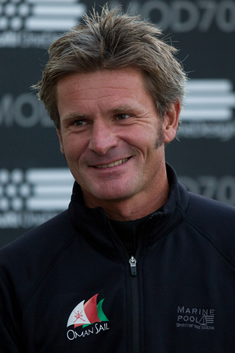 While the MOD70 has its own fully-crewed circuit one imagines the temptation for brave sailors to race them shorthanded in the Route du Rhum and the Transat Jacques Vabre will be too hard to resist. After all, outside of the Vendee Globe, they are after all the biggest events in the French offshore calendar. Gavignet says he would love to race Musandam-Oman Sail in the 2014 Route du Rhum – unfinished business for him after 2010 – but says it will be a lot harder than his previous purpose-built maxi-trimaran, even though she was more than 30ft longer.
While the MOD70 has its own fully-crewed circuit one imagines the temptation for brave sailors to race them shorthanded in the Route du Rhum and the Transat Jacques Vabre will be too hard to resist. After all, outside of the Vendee Globe, they are after all the biggest events in the French offshore calendar. Gavignet says he would love to race Musandam-Oman Sail in the 2014 Route du Rhum – unfinished business for him after 2010 – but says it will be a lot harder than his previous purpose-built maxi-trimaran, even though she was more than 30ft longer.
“It was like Sodebo - a big truck and that was easy for me and I could sail her at 100% of her polars,” he says. “That would be impossible with the MOD70. It would be more like 75-80%. You would set it up for singlehanding, but because you have to sail it on the edge and on your own on the edge...NON! As I said the trimmer needs to be on the sheets, you can’t be on the mainsheet, the traveller and on the jib sheet at the same time.”
Even fully crewed the MOD70s are a handful particularly when it is blustery. Musandam-Oman Sail nearly ended up the wrong way up as they were sailing along the French coast within sight of the finish line en route into Marseille at the end of leg four. “The wind was coming from the mountains and I think it was coming vertically down - it was just really quick. That is what was really scary - the speed of the hull coming up. We eased everything, but when you ease the main sheet and the traveller in that situation it is quite slow. Luckily I had good reflexes and put the helm the right way, but we all were thinking afterwards ‘ooh, that was close and so close to the finish...’” That would have been a very unhappy ending after leading for the majority of that leg.
And they are not alone. On the Krys Ocean Race Groupe Edmond de Rothschild had a three rudders out of the water triple bow burying, but again they survived.
But a MOD70 is a multihull and capsizing must be a case of ‘when’ not ‘if’. “I hope it doesn’t happen because the crews are experienced and we are careful,” Gavignet continues. “I think more likely is that there will be contact between the boats because it is a little too close to Extreme 40-type sailing. That would be a problem because you break the bow on the Extreme 40 you can repair it overnight. If we break the bow or the stern of a boat by bearing way behind someone you won’t be able to do that...”
Gavignet says he would love to see some more Volvo sailors or teams competing in the MOD class. “For the class we need an Anglo-Saxon team. It is too French. But it is great - our results show that sometimes non-French teams can perform. I think it is a shame that Volvo didn’t do this. I don’t fully understand that. They want to cover more miles than before to go to the markets and they go for a slower boat...”

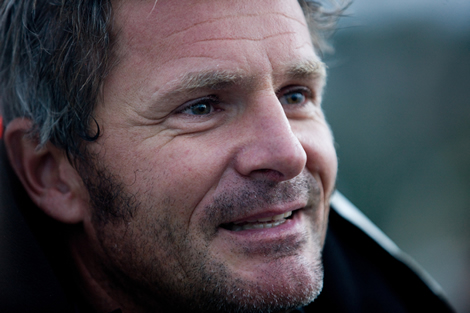
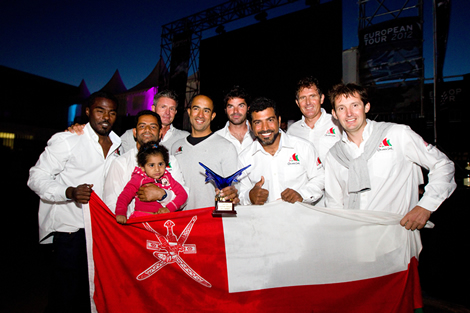
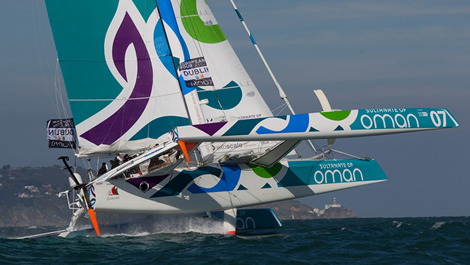
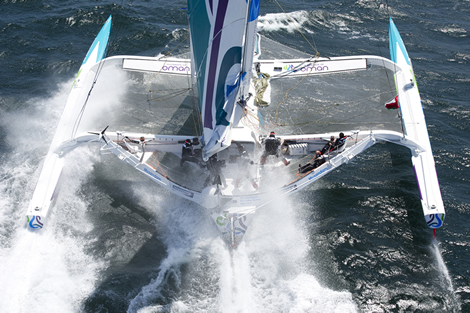








Latest Comments
wizdeas 09/10/2012 - 21:27
Fabulous!Add a comment - Members log in